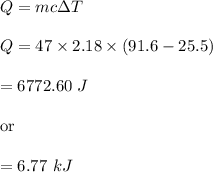

Answers: 1
Other questions on the subject: Physics

Physics, 21.06.2019 22:50, Bt758
Two horizontal plates with infinite length and width are separated by a distance h in the z direction. the bottom plate is moving at a velocity u. the incompressible fluid trapped between the plates is moving in the positive x-direction with the bottom plate. align gravity with positive z. assume that the flow is fully-developed and laminar. if the systems operates at steady state and the pressure gradient in x-direction can be ignored, do the following: 1. sketch your system 2. identify the coordinate system to be used. 3. show your coordinates and origin point on the sketch. list all your assumptions. 5. apply the continuity equation to your system. nts of navier stokes equations of choice to your system 7. solve the resulting differential equation to obtain the velocity profile within the system make sure to list your boundary conditions. check units of velocity 8. describe the velocity profile you obtain using engineering terminology. sketch that on the same sketch you provided in (1). 9. obtain the equation that describes the volumetric flow rate in the system. check the units.
Answers: 2

Physics, 21.06.2019 23:30, idjfjcjs584
Edward tolman explained the results of his study by theorizing that the rats were learning about the maze during every trial but they a. were agitated because other groups were getting reinforcement b. could not remember how to demonstrate it without reinforcement c. were not motivated to demonstrate it without reinforcement d. seemed to be too lazy to actually work without reinforcement
Answers: 3

Physics, 22.06.2019 05:20, niescarlosj
A3.9 g aluminum foil ball with a charge of +4.1×10−9 c is suspended on a string in a uniform horizontal e⃗ field. the string deviates to the right and makes an angle of 30∘ with the vertical. part a part complete what information about the e⃗ field can you determine for this situation? what information about the field can you determine for this situation? only the magnitude of e⃗ only the direction of e⃗ both the magnitude and the direction of e⃗ none of the above previous answers correct part b determine the magnitude of the electric field. express your answer with the appropriate units. e e = nothing nothing request answer part c determine the direction of the electric field. determine the direction of the electric field. to the right to the left away from you toward you
Answers: 3

Physics, 22.06.2019 20:00, rosepotato789
Choose a realistic problem for which these are the correct freebody diagrams. be sure that the answer that the problem requests is consistent with the diagrams shown. choose a realistic problem for which these are the correct freebody diagrams. be sure that the answer that the problem requests is consistent with the diagrams shown. a 1.0 kg block is placed on top of a 2.0 kg block. a horizontal rope pulls the 2.0 kg block across a frictionless floor with a force of 21.0 n. the coefficient between the two blocks is 0.75. does the 1.0 kg block on top slide?
Answers: 3
Do you know the correct answer?
The specific heat of acetic acid is 2.18 J/g°C. How many joules of heat
are needed to raise the tem...
Questions in other subjects:




Social Studies, 17.03.2021 23:40


Mathematics, 17.03.2021 23:40

Mathematics, 17.03.2021 23:40


Mathematics, 17.03.2021 23:40









